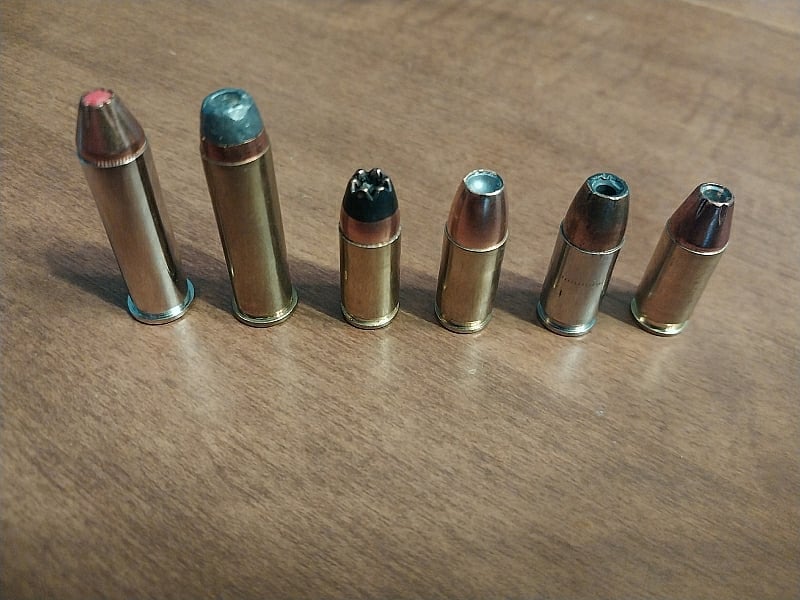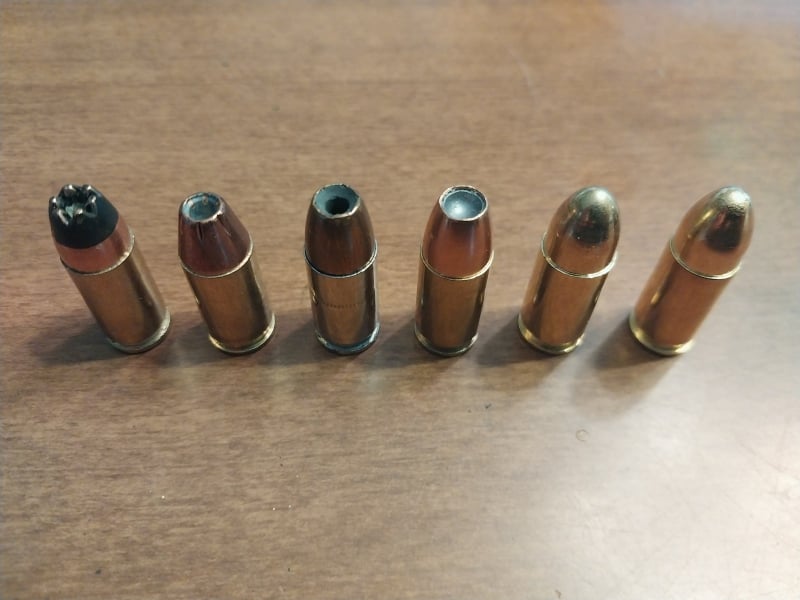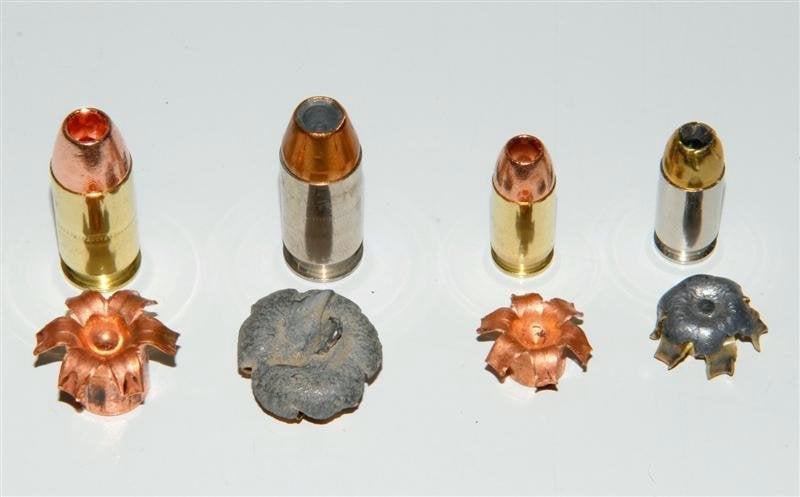If you hunt or carry a defensive firearm, or even just have a home defense gun, you likely use some form of hollow point ammunition. With good reason. Hollow points are more effective against game animals and human assailants than full metal jacket ammo, making it deadlier to the target and safer for other people in the area.

But not all hollow point bullets are the same. Technology, design choices, and desired outcomes drive how we choose our ammunition. We are fortunate to have those choices, but we need to understand what those outcomes are, and which bullets are more likely to deliver them. This article focuses on defensive handgun ammo. Hunting bullets are a topic all their own and require their own treatment, though the basic principles are the same: incapacitating the target with maximum efficiency while not endangering others by over penetrating.
Hollow Point vs. Full Metal Jacket
Before we get into how hollow point bullets work, let’s briefly distinguish them from full metal jacket bullets. If you shoot at all, you’ll need both, assuming you also have a defensive handgun. Full metal jacket (FMJ) bullets usually consist of a soft lead core surrounded by a jacket of another metal. Copper is the most common jacketing material, though I currently have a bunch of brass-jacketed ammo. FMJ bullets have a smooth round or flat nose, which enables reliable feeding in repeating firearms.

FMJ ammo costs less because it’s easier to manufacture than hollow points. FMJ rounds are great for target shooting, thanks to their cost, but they are far from the best choice for hunting or defensive ammo. Because they have a smooth, hard tip, FMJ bullets tend to go right through their targets without much deformation unless they hit a bone. Holding their shape means they deal much less damage, even if they hit a vital organ. The tendency to over penetrate also makes them dangerous to others who may be in the vicinity. Likewise, FMJ rounds are far more likely to go through walls than hollow points, endangering people on the other side.
Hollow point bullets operate differently because they have a different purpose. Let’s move on to how that works.
How do hollow point bullets function?
Basically, hollow points are designed to expand upon impact with soft tissue, delivering maximum hydrostatic shock to their target through efficient energy transfer and creating a wider wound channel. The point is to incapacitate or kill the target as efficiently as possible. The expansion also prevents or mitigates over penetration, making hollow points safer for bystanders or other people in the vicinity.
Expansion is the hollow point bullet’s primary function, and the method by which it accomplishes its purpose. Expansion is achieved through specific design parameters aimed at controlling the bullet’s expansion and maximizing its efficiency. Ammunition manufacturers each have their own philosophy for achieving those performance goals, giving defensive gun owners many choices when deciding which ammo to purchase. So, let’s look at some of those designs and what they offer.

Hollow Point Bullet Construction
Hollow points are all designed to deliver controlled expansion upon impact, but how they reach that end varies a bit. Like most FMJ rounds, hollow point bullets feature a lead core, and most have a copper jacket, indicated by the name “jacketed hollow point” bullet (JHP).
The differences, however, are obvious. Hollow points feature an open cavity on the bullet’s nose, hence the name. This cavity is designed to fill up with soft material, like body tissue, which forces the lead core to expand, which in turn peels back the copper jacket, increasing the bullet’s diameter by as much as 100%.
The expansion process is enhanced by perforating, or “skiving,” the jacket into sections. This helps control the expansion by peeling each section back like a flower petal. Each “petal” is sharp, ensuring even more tissue damage as the bullet penetrates. Some companies put a slightly different spin on skiving, sometimes literally. For instance, Remington Golden Saber rounds have angled cuts, which help the bullet continue spinning when it impacts soft flesh.
Some hollow point bullets go a step further by inserting constructs into the bullet’s front cavity. This may consist of a lead post, a cone, a wedge, or even a cross. These create extra pressure on the bullet’s outside walls, aiding expansion.
Another addition, pioneered by Hornady for their Critical Defense line, is a soft polymer insert that prevents the cavity from filling up with foreign material, such as clothing, which can prevent proper expansion. The insert also helps control the expansion process.
Expansion not only provides greater hydrostatic shock and a wider wound channel, but it also prevents or mitigates over penetration. The trick is to ensure adequate penetration while preventing a “through and through” situation where the bullet exits the target’s body with any real velocity.

Other Types of “Hollow Point” Bullets
Solid copper bullets expand almost identically as lead, but these are usually centerfire hunting rifle rounds. Frangible ammunition fragments upon impact, preventing over penetration and greatly reducing the risk of shooting through walls in a home defense situation. Frangibles are accurate, reliable, and they do the job. They make great hunting and self-defense rounds, and they are safer for shooting at steel on the range. Rare or not, ricochets are a thing. Frangible ammo does not ricochet because it disintegrates when it hits.
Choosing a Hollow Point Load
Two additional factors for which to account when choosing hollow point ammo are bullet weight and muzzle velocity. These tend to go together, because lighter bullets can move faster, but heavier bullets penetrate better. So, you have to balance weight and velocity based on your needs.
There are three basic velocity categories: sub-sonic, standard velocity, and hyper velocity. Sub-sonic ammo has a velocity of less than 1,125 feet per second (fps). Standard velocity is in the 1,200-fps range, while hyper velocity can hit 1,400, 1,500, and even a screaming 1,700 fps. Hyper velocity ammo is lighter but makes up for it with massive hydrostatic shock performance. But it can also damage your gun’s barrel. It also has a higher recoil impulse than lower velocity ammo. If you choose to run it, make sure your gun is rated for it and do your homework.
Personally, I prefer 115 and 124-grain 9mm hollow points that travel in the 1,140 to 1,180 fps range. I try both in my defensive guns and run whichever my gun seems to like best in terms of reliability, accuracy, and recoil. Revolver-wise, I like the Hornady 125-grain Critical Defense in .357 Magnum, with its 1,500-fps muzzle velocity.

Hollow Points are not Hollow Points
Some of you may be old enough to remember the old Wendy’s chicken nuggets commercial that said, “parts is parts.” If not, it was a classic. But chicken nugget ingredients aside, all hollow point bullets are not created equal. If you want to carry effectively, you should choose your defensive ammo carefully. That means deciding on bullet weight, muzzle velocity, and any add-ons like the polymer insert or angled skiving. You can consult ballistic tables to judge weight vs. velocity, and there are multiple YouTube videos and other media documenting terminal performance for various loads.
You should also test your choice in your defensive guns. Some guns are picky and hollow points are not the same as FMJ target rounds. Don’t assume your gun will like your ammo of choice. Learning that vital piece of info in a gunfight could be bad news, indeed.
So, take some time to learn about your defensive ammo. This article is merely a primer. If you want to really understand it, the resources are there. A good place to start is on the ammo manufacturers’ websites. They provide ammo specifications that you can dig into. If you’re serious about defensive firearm use, it’s worth your time. You’ll come out of it far more knowledgeable and confident, and that’s always a good thing.


